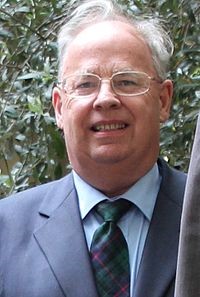Ian Morison
(Contributed by Ralph Spencer)
 Ian Morison (Courtesy of Morison Family)
Ian Morison (Courtesy of Morison Family)
Early Life
Ian was born in Felpham, near Bognor Regis, Sussex on 22 Nov 1943. He was educated at Chichester High School in 1962-1965 and then read Physics and Mathematics at Hertford College, Oxford. He had a strong interest in radio, and astronomy, building a crystal set and an optical telescope at age 11. While at Oxford he joined the University Officer Training Corp where he developed his interest in radio signalling. On graduation in 1965 he joined the radio astronomy group under Sir Bernard Lovell at Jodrell Bank. He was one of the first students to attend the MSc (Masters) course in radio astronomy which still runs. For project work he joined with John Thomson and John Ponsonby who were developing Moon radar using telescopes at Jodrell Bank. They became one of the first groups to use synthetic aperture radar, using the relative motion of the Moon and Earth to change the baseline during the observations]. Ian registered for a PhD developing a digitally controlled Doppler machine to ensure signals stayed within the narrow band (3 Hz) receiver. Ian built a specialised digital computer (SIMBAD) to drive the Doppler machine and perform the fast Fourier transforms needed for the synthesis but did not write up his thesis at the time due to illness.
Career at Jodrell Bank
Ian's expertise in electronics business was recognised and he soon became involved in building much of the digital infrastructure at Jodrell, including the station clock which produced a 1-sec pulse, synchronised to UTC to around 1 microsecond accuracy. He joined the interferometer group under Henry Palmer and was coauthor on the discovery of radio emission from a black hole candidate micro-quasar A0620-00. He was PhD supervisor for Colin Lonsdale working on the structure of extragalactic radio sources using MERLIN. He worked with John Davies to design and build a 24-bit computer to be used for on-line telescope control (Micro-Circe). This used the same machine code instruction set as the Ferranti Argus machines used previously and saving a large amount of software effort needed were commercial machines to have been bought. They used read-only memory so that they were self-booting, coming into operation in the late 1970s and used until 2008. He designed a 48-bit stack-based main-frame machine (CIRCE) which ran the FORTH language efficiently and was used for data analysis. He played a major part in the development of the MERLIN array, including telescope control and computing infrastructure]. Also important was a communication system on-site - which ran at high speed for that time, 1Mbits/sec - connecting telescopes, data recording and control desks throughout the site (Ethernet has now taken over of course). Amongst the many technical aspects he worked on in devilment of the observatory he helped design and build a X,Y Z, panel measuring machine for the production of new panels for the MkII telescope, was project scientist for SETI observations, and worked on developing optical fibre links for the e-MERLIN upgrade . His work on the station clock, starting in 1993, resulted in the lowest timing residuals for pulsars of all the European telescopes. The clock was improved by using GPS timing signals and played a major role in obtaining accurate timing data on pulsars used in the search for low-frequency gravitational waves.
In 1970 Ian was appointed lecturer in physics at the University of Manchester, giving courses on the Physics of Music, Introductory Astronomy, and running electronics classes. He continued in this role until 1989 when he was appointed systems engineer to work full time on the MERLIN upgrade after the death of John Davies, He continued some teaching duties, mainly the electronics laboratory until his retirement in 2011.
Ian was an excellent lecturer and public speaker, able to bring complex ideas to a general audience. He was made Gresham College Professor in 2007, following in the footsteps of Isaac Newton and Christopher Wren, giving over 30 lectures to the public over four years and resulting in a book. After retirement he gave many talks to the public and astronomical societies in the UK. He wrote extensively on astronomy for popular astronomy magazines, wrote 6 books aimed at amateur astronomers and overall published more than 50 works. His web page "Astronomy Digest" contains over 100 articles on telescopes and astro-photography.
![[IAU logo]](iau_wb_thumb.jpg)
![[URSI logo]](URSI-logo-thumb.jpg)
![[Karl Jansky at his antenna]](jansky_photo_02_thumb.jpg)
![[Reber's Wheaton antenna]](Reber_Telescope_Wheaton_thumb.jpg)
![[Dover Heights]](Dover_Heights_02_thumb.jpg)
![[4C telescope]](GB61-195_4C_telescope_thumb.jpg)
![[Ewen and horn antenna]](ewen_horn1s.jpg)
![[Dwingeloo, 1956]](Dwingeloo-1956-thumb.jpg)
![[Jocelyn Bell Burnell and Cambridge antenna used in pulsar discovery]](burnell2_thumb.jpg)
![[Lovell Telescope at Jodrell Bank]](site_1594_0001-500-334-20180316163019-thumb150.jpg)
![[Wilson, Penzias, and Bell Labs horn antenna]](wilson-penzias-horn_thumb.jpg)
![[6-m Millimeter Radio Telescope in Mitaka, Japan]](6m-thumb.jpg)

